Yangon
| Yangon ရန်ကုန် Rangoon | |||
|---|---|---|---|
| Metropolitan City | |||
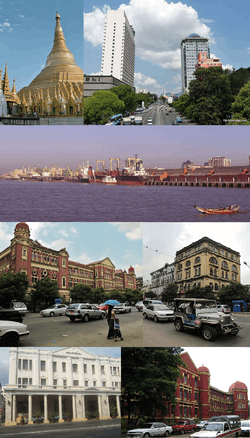 | |||
| |||
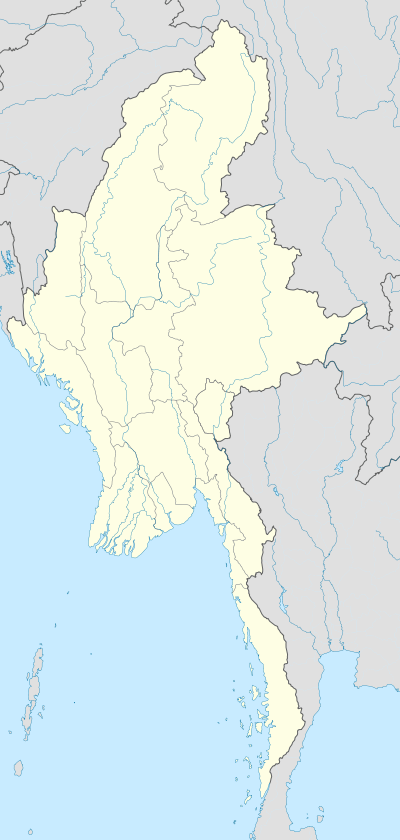 Yangon Location of Yangon, Myanmar | |||
| Coordinates: 16°51′N 96°11′E / 16.850°N 96.183°ECoordinates: 16°51′N 96°11′E / 16.850°N 96.183°E | |||
| Country | Myanmar | ||
| Region | Yangon Region | ||
| Settled | c. 1028–1043 | ||
| Government | |||
| • Mayor | Maung Maung Soe | ||
| Area[1] | |||
| • Urban | 231.18 sq mi (598.75 km2) | ||
| • Metro | 3,930 sq mi (10,170 km2) | ||
| Population (2014 Census) | |||
| • Metropolitan City | 7,360,703[2] | ||
| • Urban | 5,160,512 | ||
| • Rural | 2,200,191 | ||
| • Ethnicities | Bamar, Chinese Burmese, Burmese Indians, Chin, Rakhine, Mon, Karen, Shan, Kayah, Kachin | ||
| • Religions | Buddhism, Christianity, Hinduism, Islam | ||
| Demonym(s) | Yangoner | ||
| Time zone | MST (UTC+6:30) | ||
| Area code(s) | 01 | ||
| Vehicle registration | YGN | ||
| Website |
www | ||
Yangon (Burmese: ရန်ကုန်, MLCTS rankun mrui, pronounced: [jàɴɡòʊɴ mjo̰]; also known as Rangoon, literally: "End of Strife") is a former capital of Myanmar and the capital of Yangon Region. Yangon is the country's largest city with a population of nearly six million, and is the most important commercial centre, although the military government officially relocated the capital to the newly built city of Naypyidaw in March 2006.[3]
Although Yangon's infrastructure is undeveloped compared to that of other major cities in southeast Asia, it now has the largest number of colonial buildings in the region.[4] While many high-rise residential and commercial buildings have been constructed or renovated throughout the city centre and Greater Yangon in the past two decades, most satellite towns that ring the city continue to be deeply impoverished.
Etymology
Yangon (ရန်ကုန်) is a combination of the two words yan (ရန်) and koun (ကုန်), which mean "enemies" and "run out of", respectively. It is also translated as "End of Strife". "Rangoon" most likely comes from the British imitation of the pronunciation of "Yangon" in the Arakanese language, which is [rɔ̀ɴɡʊ́ɴ].
History
Early history
Yangon was founded as Dagon in the early 11th century (c. 1028–1043) by the Mon, who dominated Lower Burma at that time.[5] Dagon was a small fishing village centred about the Shwedagon Pagoda. In 1755, King Alaungpaya conquered Dagon, renamed it "Yangon", and added settlements around Dagon. The British captured Yangon during the First Anglo-Burmese War (1824–26), but returned it to Burmese administration after the war. The city was destroyed by a fire in 1841.[6]
Colonial Rangoon

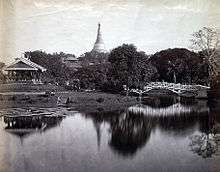
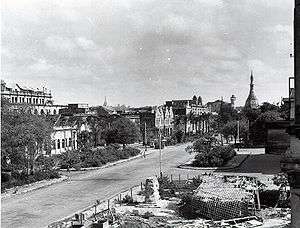
The British seized Yangon and all of Lower Burma in the Second Anglo-Burmese War of 1852, and subsequently transformed Yangon into the commercial and political hub of British Burma. Yangon is also the place where the British sent Bahadur Shah II, the last Mughal emperor, to live after the Indian Rebellion of 1857. Based on the design by army engineer Lt. Alexander Fraser, the British constructed a new city on a grid plan on delta land, bounded to the east by the Pazundaung Creek and to the south and west by the Yangon River. Yangon became the capital of all British Burma after the British had captured Upper Burma in the Third Anglo-Burmese War of 1885. By the 1890s Yangon's increasing population and commerce gave birth to prosperous residential suburbs to the north of Royal Lake (Kandawgyi) and Inya Lake.[7] The British also established hospitals including Rangoon General Hospital and colleges including Rangoon University.
Colonial Yangon, with its spacious parks and lakes and mix of modern buildings and traditional wooden architecture, was known as "the garden city of the East."[7] By the early 20th century, Yangon had public services and infrastructure on par with London.[8]
Before World War II, about 55% of Yangon's population of 500,000 was Indian or South Asian, and only about a third was Bamar (Burman).[9] Karens, the Chinese, the Anglo-Burmese and others made up the rest.
After World War I, Yangon became the epicentre of Burmese independence movement, with leftist Rangoon University students leading the way. Three nationwide strikes against the British Empire in 1920, 1936 and 1938 all began in Yangon. Yangon was under Japanese occupation (1942–45), and incurred heavy damage during World War II. The city was retaken by the Allies in May 1945.
Yangon became the capital of Union of Burma on 4 January 1948 when the country regained independence from the British Empire.
Contemporary Yangon
Soon after Burma's independence in 1948, many colonial names of streets and parks were changed to more nationalistic Burmese names. In 1989, the current military junta changed the city's English name to "Yangon", along with many other changes in English transliteration of Burmese names. (The changes have not been accepted by many Burmese who consider the junta unfit to make such changes, nor by many publications, news bureaux including, most notably, the BBC and foreign nations including the United Kingdom and United States.)[10][11]
Since independence, Yangon has expanded outwards. Successive governments have built satellite towns such as Thaketa, North Okkalapa and South Okkalapa in the 1950s to Hlaingthaya, Shwepyitha and South Dagon in the 1980s.[6] Today, Greater Yangon encompasses an area covering nearly 600 square kilometres (230 sq mi).[1]
During Ne Win's isolationist rule (1962–88), Yangon's infrastructure deteriorated through poor maintenance and did not keep up with its increasing population. In the 1990s, the current military government's more open market policies attracted domestic and foreign investment, bringing a modicum of modernity to the city's infrastructure. Some inner city residents were forcibly relocated to new satellite towns. Many colonial-period buildings were demolished to make way for high-rise hotels, office buildings, and shopping malls,[12] leading the city government to place about 200 notable colonial-period buildings under the Yangon City Heritage List in 1996.[13] Major building programs have resulted in six new bridges and five new highways linking the city to its industrial back country.[14][15][16] Still, much of Yangon remains without basic municipal services such as 24-hour electricity and regular garbage collection.
Yangon has become much more indigenous Burmese in its ethnic make-up since independence. After independence, many South Asians and Anglo-Burmese left. Many more South Asians were forced to leave during the 1960s by Ne Win's xenophobic government.[9] Nevertheless, sizable South Asian and Chinese communities still exist in Yangon. The Anglo-Burmese have effectively disappeared, having left the country or intermarried with other Burmese groups.
Yangon was the centre of major anti-government protests in 1974, 1988 and 2007. The 1988 People Power Uprising resulted in the deaths of hundreds, if not thousands of Burmese civilians, many in Yangoon where hundreds of thousands of people flooded into the streets of the then capital city. The Saffron Revolution saw mass shootings and the use of crematoria in Yangoon by the Burmese government to erase evidence of their crimes against monks, unarmed protesters, journalists and students.[17]
The city's streets saw bloodshed each time as protesters were gunned down by the government.
In May 2008, Cyclone Nargis hit Yangon. While the city had few human casualties, three quarters of Yangon's industrial infrastructure was destroyed or damaged, with losses estimated at US$800 million.[18]
In November 2005, the military government designated Naypyidaw, 320 kilometres (199 mi) north of Yangon, as the new administrative capital, and subsequently moved much of the government to the newly developed city. At any rate, Yangon remains the largest city, and the most important commercial centre of Myanmar.
Geography
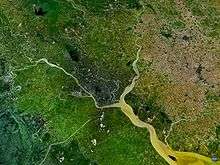
Yangon is located in Lower Burma (Myanmar) at the convergence of the Yangon and Bago Rivers about 30 km(19 mi) away from the Gulf of Martaban at 16°48' North, 96°09' East (16.8, 96.15). Its standard time zone is UTC/GMT +6:30 hours.
Climate
Yangon has a tropical monsoon climate under the Köppen climate classification system.[19] The city features a lengthy wet season from May through October where a substantial amount of rainfall is received; and a dry season from November through April, where little rainfall is seen. It is primarily due to the heavy rainfall received during the rainy season that Yangon falls under the tropical monsoon climate category. During the course of the year, average temperatures show little variance, with average highs ranging from 29 to 36 °C (84 to 97 °F) and average lows ranging from 18 to 25 °C (64 to 77 °F).
| Climate data for Yangon (1961—1990) | |||||||||||||
|---|---|---|---|---|---|---|---|---|---|---|---|---|---|
| Month | Jan | Feb | Mar | Apr | May | Jun | Jul | Aug | Sep | Oct | Nov | Dec | Year |
| Record high °C (°F) | 37.8 (100) |
38.3 (100.9) |
39.4 (102.9) |
41.1 (106) |
40.6 (105.1) |
36.7 (98.1) |
33.9 (93) |
33.9 (93) |
34.4 (93.9) |
35.0 (95) |
35.0 (95) |
35.6 (96.1) |
41.1 (106) |
| Average high °C (°F) | 32.2 (90) |
34.5 (94.1) |
36.0 (96.8) |
37.0 (98.6) |
33.4 (92.1) |
30.2 (86.4) |
29.7 (85.5) |
29.6 (85.3) |
30.4 (86.7) |
31.5 (88.7) |
32.0 (89.6) |
31.5 (88.7) |
32.3 (90.1) |
| Daily mean °C (°F) | 25.1 (77.2) |
26.9 (80.4) |
28.8 (83.8) |
30.7 (87.3) |
29.2 (84.6) |
27.4 (81.3) |
26.9 (80.4) |
26.9 (80.4) |
27.3 (81.1) |
27.9 (82.2) |
27.2 (81) |
25.3 (77.5) |
27.5 (81.5) |
| Average low °C (°F) | 17.9 (64.2) |
19.3 (66.7) |
21.6 (70.9) |
24.3 (75.7) |
25.0 (77) |
24.5 (76.1) |
24.1 (75.4) |
24.1 (75.4) |
24.2 (75.6) |
24.2 (75.6) |
22.4 (72.3) |
19.0 (66.2) |
22.6 (72.7) |
| Record low °C (°F) | 12.8 (55) |
13.3 (55.9) |
16.1 (61) |
20.0 (68) |
20.6 (69.1) |
21.7 (71.1) |
21.1 (70) |
20.0 (68) |
22.2 (72) |
21.7 (71.1) |
16.1 (61) |
12.8 (55) |
12.8 (55) |
| Average rainfall mm (inches) | 5 (0.2) |
2 (0.08) |
7 (0.28) |
15 (0.59) |
303 (11.93) |
547 (21.54) |
559 (22.01) |
602 (23.7) |
368 (14.49) |
206 (8.11) |
60 (2.36) |
7 (0.28) |
2,681 (105.55) |
| Average rainy days | 0.2 | 0.2 | 0.4 | 1.6 | 12.6 | 25.3 | 26.2 | 26.1 | 19.5 | 12.2 | 4.8 | 0.2 | 129.3 |
| Average relative humidity (%) | 62 | 66 | 69 | 66 | 73 | 85 | 86 | 87 | 85 | 78 | 71 | 65 | 74 |
| Mean monthly sunshine hours | 300 | 272 | 290 | 292 | 181 | 80 | 77 | 92 | 97 | 203 | 280 | 288 | 2,452 |
| Source #1: World Meteorological Organization,[20] Sistema de Clasificación Bioclimática Mundial (extremes)[21] | |||||||||||||
| Source #2: Danish Meteorological Institute (sun and relative humidity)[22] | |||||||||||||
Cityscape

Until the mid-1990s, Yangon remained largely constrained to its traditional peninsula setting between the Bago, Yangon and Hlaing rivers. People moved in, but little of the city moved out. Maps from 1944 show little development north of Inya Lake and areas that are now layered in cement and stacked with houses were then virtual backwaters. Since the late 1980s, however, the city began a rapid spread north to where Yangon International airport now stands. But the result is a stretching tail on the city, with the downtown area well removed from its geographic centre.[23] The city's area has steadily increased from 72.52 square kilometres (28.00 sq mi) in 1901 to 86.2 square kilometres (33.3 sq mi) in 1940 to 208.51 square kilometres (80.51 sq mi) in 1974, to 346.13 square kilometres (133.64 sq mi) in 1985, and to 598.75 square kilometres (231.18 sq mi) in 2008.[1][24]
Architecture
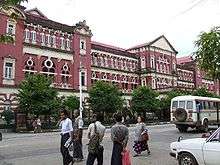
Downtown Yangon is known for its leafy avenues and fin-de-siècle architecture.[25] The former British colonial capital has the highest number of colonial period buildings in south-east Asia.[4] Downtown Yangon is still mainly made up of decaying colonial buildings. The former High Court, the former Secretariat buildings, the former St. Paul's English High School and the Strand Hotel are excellent examples of the bygone era. Most downtown buildings from this era are four-story mix-use (residential and commercial) buildings with 14-foot (4.3 m) ceilings, allowing for the construction of mezzanines. Despite their less-than-perfect conditions, the buildings remain highly sought after and most expensive in the city's property market.[26]
In 1996, the Yangon City Development Committee created a Yangon City Heritage List of old buildings and structures in the city that cannot be modified or torn down without approval.[27] In 2012, the city of Yangon imposed a 50-year moratorium on demolition of buildings older than 50 years.[28] The Yangon Heritage Trust, an NGO started by Thant Myint-U, aims to create heritage areas in Downtown, and attract investors to renovate buildings for commercial use.[28]
A latter day hallmark of Yangon is the eight-story apartment building. (In Yangon parlance, a building with no elevators (lifts) is called an apartment building and one with elevators is called a condominium.[29] Condos which have to invest in a local power generator to ensure 24-hour electricity for the elevators are beyond the reach of most Yangonites.) Found throughout the city in various forms, eight-story apartment buildings provide relatively inexpensive housing for many Yangonites. The apartments are usually eight stories high (including the ground floor) mainly because city regulations, until February 2008, required that all buildings higher than 75 feet (23 m) or eight stories install elevators.[30] The current code calls for elevators in buildings higher than 62 feet (19 m) or six stories, likely ushering in the era of the six-story apartment building. Although most apartment buildings were built only within the last 20 years, they look much older and rundown due to shoddy construction and lack of proper maintenance.
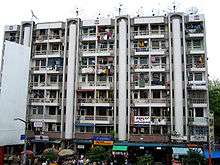
Unlike other major Asian cities, Yangon does not have any skyscrapers. Aside from a few high-rise hotels and office towers, most high-rise buildings (usually 10 stories and up) are "condos" scattered across prosperous neighbourhoods north of downtown such as Bahan, Dagon, Kamayut and Mayangon. The tallest building in Yangon, Pyay Gardens, is a 25-story condo in the city's north.
Older satellite towns such as Thaketa, North Okkalapa and South Okkalapa are lined mostly with one to two story detached houses with access to the city's electricity grid. Newer satellite towns such as North Dagon and South Dagon are still essentially slums in a grid layout. The satellite towns—old or new—receive little or no municipal services.
Road layout

Downtown Yangon's road layout follows a grid pattern, based on four types of roads:
- Broad 49-m wide roads running west to east
- Broad 30-m wide roads running south to north
- Two narrow 9.1-m wide streets running south to north
- Mid-size 15-m wide streets running south to north
The east-west grid of central was laid out by British military engineers Fraser and Montgomerie after the Second Anglo-Burmese War.[8] The city was later developed by the Public Works Department and Bengal Corps of Engineers. The pattern of south to north roads is as follows: one broad 100-foot (30 m) wide broad road, two narrow streets, one mid-size street, two more narrow streets, and then another 100-foot (30 m) wide broad road. This order is repeated from west to east. The narrow streets are numbered; the medium and broad roads are named.
For example, the 100-foot (30 m) Lanmadaw Road is followed by 30-foot (9.1 m)-wide 17th and 18th streets then the medium 50-foot (15 m) Sint-Oh-Dan Road, the 30-foot 19th and 20th streets, followed by another 100-foot (30 m) wide Latha Road, followed again by the two numbered small roads 21st and 22nd streets, and so on.
The roads running parallel west to east were the Strand Road, Merchant Road, Maha Bandula (née Dalhousie) Road, Anawrahta (Fraser) Road, and Bogyoke Aung San (Montgomerie) Road.
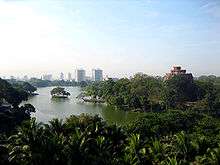
Parks and gardens
The largest and best maintained parks in Yangon are located around Shwedagon Pagoda. To the south-east of the gilded stupa is the most popular recreational area in the city – Kandawgyi Lake. The 150-acre (61-ha) lake is surrounded by the 110-acre (45-ha) Kandawgyi Nature Park,[31] and the 69.25-acre (28-ha) Yangon Zoological Gardens, which consists of a zoo, an aquarium and an amusement park.[32] West of the pagoda towards the former Hluttaw (Parliament) complex is the 130-acre (53-ha) People's Square and Park, (the former parading ground on important national days when Yangon was the capital.)[33] A few miles north of the pagoda lies the 37-acre (15-ha) Inya Lake Park – a favorite hangout place of Yangon University students, and a well-known place of romance in Burmese popular culture.
Hlawga National Park and Allied War Memorial at the outskirts of the city are popular day-trip destinations with the well-to-do and tourists.
Administration
Yangon is administered by the Yangon City Development Committee (YCDC). YCDC also coordinates urban planning.[34] The city is divided into four districts. The districts combined have a total of 33 townships. The current mayor of Yangon is Hla Myint. Each township is administered by a committee of township leaders, who make decisions regarding city beautification and infrastructure. Myo-thit (lit. "New Towns", or satellite towns) are not within such jurisdictions.
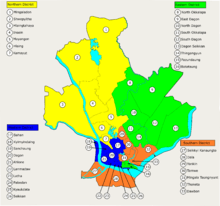
| Western District (Downtown) | Eastern District | Southern District | Northern District |
|---|---|---|---|
Yangon is a member of Asian Network of Major Cities 21.
Transport
Yangon is Burma's main domestic and international hub for air, rail, and ground transportation.
Air

Yangon International Airport, located 12 miles (19 km) from the centre, is the country's main gateway for domestic and international air travel. The airport currently has two main international terminals, known as T1 and T2, and a domestic terminal. It has direct flights to regional cities in Asia – mainly, Doha, Dubai, Dhaka, Kolkata, Hanoi, Ho Chi Minh City, Hong Kong, Tokyo, Beijing, Seoul, Guangzhou, Taipei, Bangkok, Kuala Lumpur, Kunming and Singapore. Although domestic airlines offer service to about twenty domestic locations, most flights are to tourist destinations such as Bagan, Mandalay, Heho and Ngapali, and to the capital Naypyidaw.
Railways
Yangon Central Railway Station is the main terminus of Myanmar Railways' 5,403-kilometre (3,357 mi) rail network[35] whose reach covers Upper Myanmar (Naypyidaw, Mandalay, Shwebo), upcountry (Myitkyina), Shan hills (Taunggyi, Lashio) and the Taninthayi coast (Mawlamyaing, Dawei).
Yangon Circular Railway operates a 45.9-kilometre (28.5 mi) 39-station commuter rail network that connects Yangon's satellite towns. The system is heavily utilized by the local populace, selling about 150,000 tickets daily.[36] The popularity of the commuter line has jumped since the government reduced petrol subsidies in August 2007.[36]
Buses and cars
Yangon has a 4,456-kilometre (2,769 mi) road network of all types (tar, concrete and dirt) in March 2011. Many of the roads are in poor condition and not wide enough to accommodate an increasing number of cars.[37] The vast majority of Yangon residents cannot afford a car and rely on an extensive network of buses to get around. Over 300 public and private bus lines operate about 6,300 crowded buses around the city, carrying over 4.4 million passengers a day.[1][38] All buses and 80% of the taxis in Yangon run on compressed natural gas (CNG), following the 2005 government decree to save money on imported petroleum.[39] Highway buses to other cities depart from Dagon Ayeyar Highway Bus Terminal for Irrawaddy delta region and Aung Mingala Highway Bus Terminal for other parts of the country.[40]
Motor transportation in Yangon is highly expensive for most of its citizens. As the government allows only a few thousand cars to be imported each year in a country with over 50 million people,[41] car prices in Yangon (and in Burma) are among the highest in the world. In July 2008, the two most popular cars in Yangon, 1986/87 Nissan Sunny Super Saloon and 1988 Toyota Corolla SE Limited, cost the equivalent of about US$20,000 and US$29,000 respectively.[42] A sports utility vehicle, imported for the equivalent of around US$50,000, goes for US$250,000.[41] Illegally imported unregistered cars are cheaper – typically about half the price of registered cars. Nonetheless, car usage in Yangon is on the rise, a sign of rising incomes for some, and already causes much traffic congestion in highway-less Yangon's streets. In 2011, Yangon had about 300,000 registered motor vehicles in addition to an unknown number of unregistered ones.[37]
Since 1970, cars have been driven on the right side of the road in Burma, as part of a military decree.[43] However, as the government has not required left hand drive (LHD) cars to accompany the right side road rules, many cars on the road are still right hand drive (RHD) made for driving on the left side. Japanese used cars, which make up most of the country's imports, still arrive with RHD and are never converted to LHD. As a result, Burmese drivers have to rely on their passengers when passing other cars.

Within Yangon city limits, it is illegal to drive trishaws, bicycles, and motorcycles. Since February 2010, pickup truck bus lines have been forbidden to run in 6 townships of central Yangon, namely Latha, Lanmadaw, Pabedan, Kyauktada, Botahtaung and Pazundaung Townships.[44] In May 2003, a ban on using car horns was implemented in six townships of Downtown Yangon to reduce noise pollution.[45] In April 2004, the car horn ban was expanded to cover the entire city.[45]
River
Yangon's four main passenger jetties, all located on or near downtown waterfront, mainly serve local ferries across the river to Dala and Thanlyin, and regional ferries to the Irrawaddy delta.[46] The 22-mile (35 km) Twante Canal was the quickest route from Yangon to the Irrawaddy delta until the 1990s when roads between Yangon and the Irrawaddy Division became usable year-round. While passenger ferries to the delta are still used, those to Upper Burma via the Irrawaddy river are now limited mostly to tourist river cruises.
Demographics
| Historical population | ||
|---|---|---|
| Year | Pop. | ±% |
| 1824 | 10,000 | — |
| 1856 | 46,000 | +360.0% |
| 1872 | 100,000 | +117.4% |
| 1881 | 165,000 | +65.0% |
| 1891 | 181,000 | +9.7% |
| 1901 | 248,000 | +37.0% |
| 1911 | 295,000 | +19.0% |
| 1921 | 340,000 | +15.3% |
| 1931 | 400,000 | +17.6% |
| 1941 | 500,000 | +25.0% |
| 1950 | 1,302,000 | +160.4% |
| 1960 | 1,592,000 | +22.3% |
| 1970 | 1,946,000 | +22.2% |
| 1980 | 2,378,000 | +22.2% |
| 1990 | 2,907,000 | +22.2% |
| 2000 | 3,553,000 | +22.2% |
| 2010 | 4,348,000 | +22.4% |
| 2020 | 5,361,000 | +23.3% |
| 2025 | 5,869,000 | +9.5% |
| Sources: 1846,[6] 1872–1941,[9] 1950–2025[47] | ||
Yangon is the most populous city by far in Burma although estimates of the size of its population vary widely. All population figures are estimates since no official census has been conducted in Burma since 1983. A UN estimate[47] puts the population as 4.35 million in 2010 but a 2009 U.S. State Department estimate[48] puts it at 5.5 million. The U.S. State Department's estimate is probably closer to the real number since the UN number is a straight-line projection, and does not appear to take the expansion of city limits in the past two decades into account. The city's population grew sharply after 1948 as many people (mainly, the indigenous Burmese) from other parts of the country moved into the newly built satellite towns of North Okkalapa, South Okkalapa, and Thaketa in the 1950s and East Dagon, North Dagon and South Dagon in the 1990s. Immigrants have founded their regional associations (such as Mandalay Association, Mawlamyaing Association, etc.) in Yangon for networking purposes. The government's decision to move the nation's administrative capital to Naypyidaw has drained an unknown number of civil servants away from Yangon.
Yangon is the most ethnically diverse city in the country. While Indians formed the slight majority prior to World War II,[9] today, the majority of the population is of indigenous Bamar (Burman) descent. Large communities of Indians/South Asian Burmese and the Chinese Burmese exist especially in the traditional downtown neighborhoods. A large number of Rakhine and Karen also live in the city.
Burmese is the principal language of the city. English is by far the preferred second language of the educated class. In recent years, however, the prospect of overseas job opportunities has enticed some to study other languages: Mandarin Chinese is most popular, followed by Japanese, and French.[49]
Religions
The primary religions practiced in Yangon are Buddhism, Christianity, Hinduism, and Islam. Shwedagon Pagoda is a famous religious landmark in the city.
Media

Yangon is the country's hub for the movie, music, advertising, newspaper and book publishing industries. All media is heavily regulated by the military government. Television broadcasting is off limits to the private sector. All media content must first be approved by the government's media censor board, Press Scrutiny and Registration Division.[50]
Most television channels in the country are broadcast from Yangon. TV Myanmar and Myawaddy TV are the two main channels, providing Burmese-language programming in news and entertainment. Other special interest channels are MWD-1 and MWD-2, MRTV-3, the English-language channel that targets overseas audiences via satellite and via Internet, MRTV-4 and Channel 7 are with a focus on non-formal education programs and movies, and Movie 5, a pay-TV channel specializing in broadcasting foreign movies.[51]
Yangon has three radio stations. Myanmar Radio National Service is the national radio service and broadcasts mostly in Burmese (and in English during specific times.) Pop culture oriented Yangon City FM and Mandalay City FM radio stations specialize in Burmese and English pop music, entertainment programs, live celebrity interviews, etc. New radio channels such as Shwe FM and Pyinsawaddy FM can also be tuned with the city area.
Nearly all print media and industries are based out of Yangon. All three national newspapers – two Burmese language dailies Myanma Alin (မြန်မာ့အလင်း) and Kyemon (ကြေးမုံ), and the English language The New Light of Myanmar — are published by the government. Semi-governmental The Myanmar Times weekly, published in Burmese and in English, is mainly geared for Yangon's expatriate community. Over twenty special interest journals and magazines covering sports, fashion, finance, crime, literature (but never politics) vie for the readership of the general populace.
Access to foreign media is extremely difficult. Satellite television in Yangon, and in Burma, is very expensive as the government imposes an annual registration fee of one million kyats.[50] Certain foreign newspapers and periodicals such as the International Herald Tribune and the Straits Times can be found only in a few (mostly downtown) bookstores. Internet access in Yangon, which has the best telecommunication infrastructure in the country, is slow and erratic at best, and the Burmese government implements one of the world's most restrictive regimes of Internet control.[52] International text messaging and voice messaging was permitted only in August 2008.[53]
Communication
Common facilities taken for granted elsewhere are luxury prized items in Yangon and Burma. The price of a GSM mobile phone was about K1.1 million in August 2008.[53] In 2007, the country of 55 million had only 775,000 phone lines (including 275,000 mobile phones),[54][55] and 400,000 computers.[54] Even in Yangon, which has the best infrastructure, the estimated telephone penetration rate was only 6% at the end of 2004, and the official waiting time for a telephone line was 3.6 years.[56] Most people cannot afford a computer and have to use the city's numerous Internet cafes to access a heavily restricted Internet, and a heavily censored local intranet.[52] According to official statistics, in July 2010, the country had over 400,000 Internet users, with the vast majority hailing from just two cities, Yangon and Mandalay. Although Internet access was available in 42 cities across the country, the number of users outside the two main cities was just over 10,000.[57]
Lifestyle
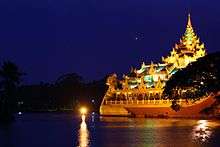
Yangon's property market is the most expensive in the country and beyond the reach of most Yangonites. Most rent outside the centre and few can afford to rent such apartments. (In 2008, rents for a typical 650-to-750-square-foot (60 to 70 m2) apartments in the centre and vicinity range between K70,000 and K150,000 and those for high end condos between K200,000 and K500,000.)[58]
Most men of all ages (and some women) spend their time at ubiquitous tea-shops, found in any corner or street of the city. Watching European football (mostly English Premier League with occasional La Liga, Serie A, Bundesliga) matches while sipping tea is a popular pastime among many Yangonites. The average person stays close to his or her residential neighbourhood. The well-to-do tend to visit shopping malls and parks on weekends. Some leave the city on weekends for Chaungtha and Ngwesaung beach resorts in Ayeyarwady Division.
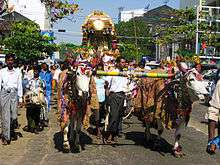
Yangon is also home to many pagoda festivals (paya pwe), held during dry-season months (November – March). The most famous of all, the Shwedagon Pagoda Festival in March, attracts thousands of pilgrims from around the country.
Yangon's museums are the domain of tourists and rarely visited by the locals.
Most of Yangon's larger hotels offer some kind of nightlife entertainment, geared towards tourists and the well-to-do Burmese. Some hotels offer traditional Burmese performing arts shows complete with a traditional Burmese orchestra. The pub scene in larger hotels is more or less the same as elsewhere in Asia. Other options include karaoke bars and pub restaurants in Yangon Chinatown.
Due to the problems of high inflation, the lack of high denomination notes, and the fact that many of the population do not have access to checks, or credit or debit cards, it is common to see citizens carrying a considerable amount of cash.[59] (The highest denomination of Burmese currency kyat is 10 000 (~US$10.)) Credit cards are only rarely used in the city, chiefly in the more lavish hotels.
Sports
As the city has the best sporting facilities in the country, most national-level annual sporting tournaments such as track and field, football, volleyball, tennis and swimming are held in Yangon. The 40,000-seat Aung San Stadium and the 32,000-seat Thuwunna Stadium are the main venues for the highly popular annual State and Division football tournament. Until April 2009, the now defunct Myanmar Premier League, consisted of 16 Yangon-based clubs,[60] played all its matches in Yangon stadiums, and attracted little interest from the general public or commercial success despite the enormous popularity of football in Burma. Most Yangonites prefer watching European football on satellite TV. Teams such as Manchester United, Liverpool, Chelsea, Real Madrid, Barcelona, Bayern Munich and Manchester City are among the favorite European teams among the Yangonites. It remains to be seen whether the Myanmar National League, the country's first professional football league, and its Yangon-based club Yangon United FC will attract a sufficient following in the country's most important media market.
Yangon is also home to annual the Myanmar Open golf tournament, and the Myanmar Open tennis tournament. The city hosted the 1961 and 1969 South East Asian Games. During colonial times, cricket was played mostly by British officials in the city. First-class cricket was played in the city in January 1927 when the touring Marylebone Cricket Club played Burma and the Rangoon Gymkhana. Two grounds were used to host these matches, the BAA Ground and the Gymkhana Ground.[61][62] These matches mark the only time Burma and Rangoon Gymkhana have appeared in first-class cricket, and the only time first-class cricket has been played in Burma. After independence cricket all but died out in the country.
Yangon has a growing population of skateboarders, as documented in the films Altered Focus: Burma and Youth of Yangon. German non-profit organization Make Life Skate Life has received permission from the Yangon City Development Committee to construct a concrete skatepark at Thakin Mya park in downtown, and plans to complete the park in November 2015.[63]
Economy
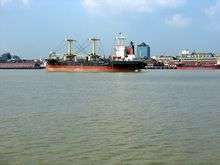
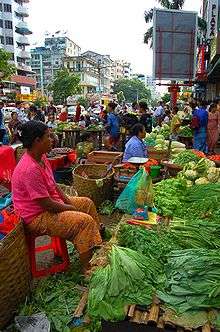
Yangon is the country's main centre for trade, industry, real estate, media, entertainment and tourism. The city represents about one fifth of the national economy. According to official statistics for FY 2010–2011, the size of the economy of Yangon Region was 8.93 trillion kyats, or 23% of the national GDP.[64]
The city is Lower Burma's main trading hub for all kinds of merchandise – from basic food stuffs to used cars although commerce continues to be hampered by the city's severely underdeveloped banking industry and communication infrastructure. Bayinnaung Market is the largest wholesale centre in the country for rice, beans and pulses, and other agricultural commodities.[65] Much of the country's legal imports and exports go through Thilawa Port, the largest and busiest port in Burma. There is also a great deal of informal trade, especially in street markets that exist alongside street platforms of Downtown Yangon's townships. However, on 17 June 2011, the YCDC announced that street vendors, who had previously been allowed to legally open shop at 3 pm, would be prohibited from selling on the streets, and permitted to sell only in their townships of residence, presumably to clean up the city's image.[66] Since 1 December 2009, high-density polyethylene plastic bags have been banned by city authorities.[67]
Manufacturing accounts for a sizable share of employment. At least 14 light industrial zones ring Yangon,[68] directly employing over 150,000 workers in 4,300 factories in early 2010.[69] The city is the centre of country's garment industry which exported US$292 million in 2008/9 fiscal year. More than 80 percent of factory workers in Yangon work on a day-to-day basis. Most are young women between 15 and 27 years of age who come from the countryside in search of a better life.[70] The manufacturing sector suffers from both structural problems (e.g. chronic power shortages) and political problems (e.g. economic sanctions). In 2008, Yangon's 2500 factories alone needed about 120 MW of power;[71] yet, the entire city received only about 250 MW of the 530 MW needed.[72] Chronic power shortages limit the factories' operating hours between 8 am and 6 pm.[73]
Construction is a major source of employment. The construction industry has been negatively affected by the move of state apparatus and civil servants to Naypyidaw,[74] new regulations introduced in August 2009 requiring builders to provide at least 12 parking spaces in every new high-rise building, and the general poor business climate. As of January 2010, the number of new high-rise building starts approved in 2009–2010 was only 334, compared to 582 in 2008–2009.[75]
Tourism represents a major source of foreign currency for the city although by south-east Asian standards the number of foreign visitors to Yangon has always been quite low—about 250,000 before the Saffron Revolution in September 2007. The number of visitors dipped even further following the Saffron Revolution and Cyclone Nargis.[76] The recent improvement in the country's political climate has attracted an increasing number of businessmen and tourists. Between 300,000 and 400,000 visitors that went through Yangon International in 2011. However, after years of underinvestment, Yangon's modest hotel infrastructure—only 3000 of the total 8000 hotel rooms in Yangon are "suitable for tourists"—is already bursting at seams, and will need to be expanded to handle additional visitors.[77] As part of an urban development strategy, a hotel zone has been planned in Yangon's outskirts, encompassing government- and military-owned land in Mingaladon, Hlegu and Htaukkyant Townships.[78]
Education

Yangon has the best educational facilities and the highest number of qualified teachers in Burma where state spending on education is among the lowest in the world.[79] A 2007 estimate by the London-based International Institute for Strategic Studies puts the spending for education at 0.5% of the national budget.[80] The disparity in educational opportunities and achievement between rich and poor schools is quite stark even within the city. With little or no state support forthcoming, schools have to rely on forced "donations" and various fees from parents for nearly everything – school maintenance to teachers' salaries,[81] forcing many poor students to drop out.
While many students in poor districts fail to reach high school, a handful of Yangon high schools in wealthier districts such as Dagon 1, Sanchaung 2, Kamayut 2, Bahan 2, Latha 2, and TTC provide the majority of students admitted to the most selective universities in the country, highlighting the extreme shallowness of talent pool in the country.[82] The wealthy bypass the state education system altogether, sending their children to private English language instruction schools such as YIEC or more widely known as ISM, or abroad (typically Singapore or Australia) for university education.[83] In 2008, international schools in Yangon cost at least US$8,000 a year.[84]
There are over 20 universities and colleges in the city. While Yangon University remains the best known (its main campus is a part of popular Burmese culture e.g. literature, music, film, etc.), the nation's oldest university is now mostly a graduate school, deprived of undergraduate studies. Following the 1988 nationwide uprising, the military government has repeatedly closed universities, and has dispersed most of undergraduate student population to new universities in the suburbs such as Dagon University, the University of East Yangon and the University of West Yangon. Nonetheless many of the country's most selective universities are still in Yangon. Students from around the country still have to come to study in Yangon as some subjects are offered only at its universities. The University of Medicine 1, University of Medicine 2, Yangon Technological University, University of Computer Studies and Myanmar Maritime University are the most selective in the country.[85]
Health care
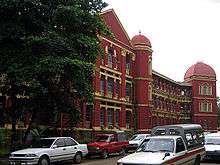
The general state of health care in Yangon is poor. According to a 2007 estimate, the military government spends 0.4% of the national budget on health care, and 40% to 60% on defense.[80] By the government's own figures, it spends 849 kyats (US$0.85) per person.[86] Although health care is nominally free, in reality, patients have to pay for medicine and treatment, even in public clinics and hospitals. Public hospitals including the flagship Yangon General Hospital lack many of the basic facilities and equipment.
Wealthier Yangonites still have access to country's best medical facilities and internationally qualified doctors. Only Yangon and Mandalay have any sizable number of doctors left as many Burmese doctors have emigrated. The well-to-do go to private clinics or hospitals like Pun Hlaing International Hospital and Bahosi Medical Clinic. Medical malpractice is widespread, even in private clinics and hospitals that serve the well-to-do. In 2009 and 2010, a spate of high-profile deaths[86] brought out the severity of the problem, even for the relatively well off Yangonites. The wealthy do not rely on domestic hospitals and travel abroad, usually Bangkok or Singapore, for treatment.[87]
The following are healthcare facilities in Yangon in 2010–2011.[37]
| FY 2010–2011 | # of public hospitals | # of private hospitals | Physician-patient ratio |
|---|---|---|---|
| Eastern District | 16 | 10 | 1:3638 |
| Western District | 10 | 21 | 1:1400 |
| Southern District | 23 | 1 | 1:18,176 |
| Northern District | 25 | 5 | 1:13,647 |
Notable sites

Pagodas
- Shwedagon Pagoda
- Sule Pagoda
- Botataung Pagoda
- Chaukhtatgyi Buddha Temple
- Kyauktawgyi Buddha Temple
- Kaba Aye Pagoda
- Maha Wizaya Pagoda
- Ye Le Pagoda
Recreation
- Allied War Memorial
- Bogyoke Market (Scott's Market)
- Hlawga National Park
- Inya Lake (formerly Lake Victoria)
- Kandawgyi Lake (formerly Royal Lake)
- Kandawmin Garden Mausolea
- Maha Bandula Park
- Martyrs' Mausoleum
- People's Square and Park
- St Mary's Cathedral
- Sain Lane So Pyae Garden
- Yangon University
- Yangon Zoological Gardens (Yangon Zoo)
Museums and art galleries
- National Museum of Myanmar
- Myanmar Gems Museum
- Bogyoke Aung San Museum
- Yangon Drugs Elimination Museum
- The Planetarium
Concert halls and theatres
- Yangon National Theatre
- Myanmar Convention Centre
International relations
Yangon is a member of the Asian Network of Major Cities 21.
Twin towns – sister cities
Yangon is twinned with:
 Yangzhou, Jiangsu, China (1997)[88]
Yangzhou, Jiangsu, China (1997)[88] Kunming, Yunnan, China (2008)
Kunming, Yunnan, China (2008) Nanning, Guangxi, China (2009)[89]
Nanning, Guangxi, China (2009)[89] Ho Chi Minh City, Vietnam (2012)[90]
Ho Chi Minh City, Vietnam (2012)[90] Busan, South Korea (2013)[91]
Busan, South Korea (2013)[91] Turin, Italy (2013)[92]
Turin, Italy (2013)[92] San Francisco, United States (2014)[93]
San Francisco, United States (2014)[93]
Image gallery


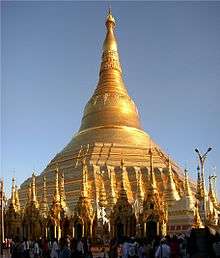 Shwedagon Pagoda
Shwedagon Pagoda- Sule Pagoda
- The bell in Swe Dagon pagoda
 Downtown Yangon, facing Sule Pagoda and Hlaing River
Downtown Yangon, facing Sule Pagoda and Hlaing River Central Yangon at night
Central Yangon at night- Karaweik Palace on Kandawgyi Lake
- Chauk Htat Gyi Pagoda
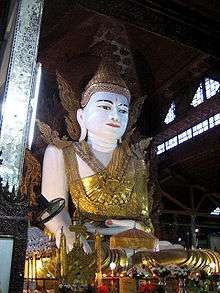 Ngahtatgyi Buddha image
Ngahtatgyi Buddha image Central Yangon
Central Yangon- Yangon River Jetty
 Yangon City Hall seen from Mahabandula Park
Yangon City Hall seen from Mahabandula Park Buildings in downtown Yangon
Buildings in downtown Yangon A jewellery market in Bogyoke Aung San Market
A jewellery market in Bogyoke Aung San Market A downtown market
A downtown market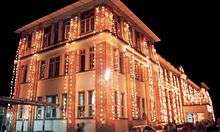 Basic Education High School No. 1 Dagon (Methodist English High School)
Basic Education High School No. 1 Dagon (Methodist English High School)- Basic Education High School No. 6 Botataung (St. Paul's High School)
- Basic Education High School No. 2 Latha (St John's Convent School)
 Thingyan, Burmese New Year
Thingyan, Burmese New Year The Independence Monument
The Independence Monument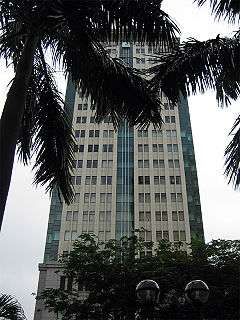 Sakura Tower
Sakura Tower Yangon High Court
Yangon High Court City view
City view- Train
- Bus(now new buses)
 Traffic jam near Yangon port
Traffic jam near Yangon port- Electric generators in front of an apartment building
 Yangon Strand-Road and sunset
Yangon Strand-Road and sunset
References
- 1 2 3 4 "Third Regional EST Forum: Presentation of Myanmar" (PDF). Singapore: Ministry of Transport, Myanmar. 17–19 March 2008.
- ↑ Census Report. The 2014 Myanmar Population and Housing Census. 2. Naypyitaw: Ministry of Immigration and Population. May 2015. p. 31.
- ↑ "Burma's new capital stages parade". BBC News. 27 March 2006. Retrieved 3 August 2006.
- 1 2 Martin, Steven (30 March 2004). "Burma maintains bygone buildings". BBC News. Retrieved 22 May 2006.
- ↑ Founded during the reign of King Pontarika, per Charles James Forbes Smith-Forbes (1882). Legendary History of Burma and Arakan. The Government Press. p. 20.; the king's reign was 1028 to 1043 per Harvey, G. E. (1925). History of Burma: From the Earliest Times to 10 March 1824. London: Frank Cass & Co. Ltd. p. 368.
- 1 2 3 Kyaw Kyaw (2006). Frauke Krass; Hartmut Gaese; Mi Mi Kyi, eds. Megacity yangon: transformation processes and modern developments. Berlin: Lit Verlag. pp. 333–334. ISBN 3-8258-0042-3.
- 1 2 "Yangon Summary Review and Analysis". Bookrags.com. 17 October 2005. Retrieved 17 April 2010.
- 1 2 Falconer, John; et al. (2001). Burmese Design & Architecture. Hong Kong: Periplus. ISBN 962-593-882-6.
- 1 2 3 4 Tin Maung Maung Than (1993). Indian Communities in south-east Asia - Some Aspects of Indians in Rangoon. Institute of south-east Asian Studies. pp. 585–587. ISBN 9789812304186.
- ↑ Who, What, Why? (26 September 2007). "Should it be Burma or Myanmar?". BBC News. Retrieved 17 April 2010.
- ↑ "Background Note: Burma". Bureau of East Asian and Pacific Affairs, US Department of State. Retrieved 1 January 2009.
- ↑ Edward Blair (1 May 2006). "Beyond Rangoon". The Irrawaddy.
- ↑ "Special Report". 4 November 2001.
- ↑ Zaw Htet. "Pioneering FMI City 'the best in Yangon'". The Myanmar Times.
- ↑ "Yangon-Thanlyin Bridge". Retrieved 7 September 2008.
- ↑ Kyi Kyi Hla (1 February 2001). "Ngamoeyeik Bridge".
- ↑ Burmese Human Rights Yearbook, 2007, http://www.burmalibrary.org/show.php?cat=1320&lo=d&sl=0
- ↑ Ye Lwin (14 July 2008). "Long road back for industrial recovery". The Myanmar Times.
- ↑ Peel, M. C. and Finlayson, B. L. and McMahon, T. A. (2007). "Updated world map of the Köppen–Geiger climate classification" (PDF). Hydrol. Earth Syst. Sci. 11: 1633–1644. doi:10.5194/hess-11-1633-2007. ISSN 1027-5606.
- ↑ "World Weather Information Service – Yangon". World Meteorological Organization. Retrieved 8 May 2012.
- ↑ "Burma (Myanmar) - Rangun" (in Spanish). Centro de Investigaciones Fitosociológicas. Retrieved February 23, 2013.
- ↑ Cappelen, John; Jensen, Jens. "Myanmar - Rangoon" (PDF). Climate Data for Selected Stations (1931-1960) (in Danish). Danish Meteorological Institute. p. 189. Archived from the original (PDF) on 27 April 2013. Retrieved February 23, 2013.
- ↑ May Thanda Win (16 July 2006). "The Future of Yangon". The Myanmar Times.
- ↑ Zin Nwe Myint (2006). Frauke Krass; Hartmut Gaese; Mi Mi Kyi, eds. Megacity yangon: transformation processes and modern developments. Berlin: Lit Verlag. p. 264. ISBN 3-8258-0042-3.
- ↑ Tom Wright (23 January 2009). "Asia's Lost Treasure Trove". WSJ Weekend Journal.
- ↑ Htar Htar Khin (15 December 2008). "Demand for downtown's golden oldies still strong". The Myanmar Times. Archived from the original on 14 February 2012.
- ↑ Kennedy, Phoebe (20 February 2011). "Colonial past could be the saving of Rangoon". The Independent. Retrieved 10 March 2012.
- 1 2 Robinson, Gwen (9 March 2012). "Myanmar pushes to save colonial buildings". Financial Times. Retrieved 10 March 2012.
- ↑ "City living: condos vs apartments". The Myanmar Times. 1 September 2007.
- ↑ Yi Yi Htwe (10 March 2008). "Lift regulation changed". The Myanmar Times.
- ↑ "Kandawgyi Garden". Retrieved 21 December 2006.
- ↑ "History of Zoological Gardens (Yangon)". Retrieved 27 September 2008.
- ↑ "Nation's Capital Yangon". Retrieved 9 October 2008.
- ↑ "Yangon". Asian Network of Major Cities 21. Archived from the original on 20 June 2006. Retrieved 13 August 2006.
- ↑ "MR to link Mandalay and Bhamo". New Light of Myanmar. 22 February 2010.
- 1 2 Yeni (30 January 2008). "The Railway Bazaar". The Irrawaddy.
- 1 2 3 "Discussion on a 30-Year Development Plan for Yangon". Weekly Eleven (in Burmese). Eleven Media Group. 18 December 2011.
- ↑ Yan Naing Hein. "First private bus line in Yangon launched". The Myanmar Times.
- ↑ Wai Moe (14 October 2008). "Rangoon Commuters Afraid of Gas Explosions". The Irrawaddy.
- ↑ "Getting Around Yangon". Myanmar's Net. Retrieved 14 October 2008.
- 1 2 "Burmese Economy Is an Obstacle to Aid". The New York Times. 29 May 2008.
- ↑ Thomas Kean (2 June 2008). "Clash of the titans on streets of Yangon". The Myanmar Times.
- ↑ "Burma Makes Road Switch". The New York Times. 7 December 1970. Retrieved 22 May 2010.
- ↑ Nay Nwe Moe Aung (24 February 2010). "Authorities ban light truck buses in downtown areas". Myanmar Times. Retrieved 18 August 2011.
- 1 2 Shwe Yinn Mar Oo (10 December 2007). "Vehicle horn penalties increased". Myanmar Times. Retrieved 18 August 2011.
- ↑ "Yangon – Getting there and around". Lonely Planet. Retrieved 26 July 2009.
- 1 2 "United Nations World Urbanization Prospects, 2007 revision". United Nations. Archived from the original on 23 December 2009. Retrieved 27 April 2010.
- ↑ "Background note: Burma". US Department of State. Retrieved 6 March 2010.
- ↑ Kyaw Soe Linn & Phyo Wai Kyaw (14 May 2007). "Language training centres open doors to new worlds". The Myanmar Times.
- 1 2 Yeni (1 March 2008). "Burma: The Censored Land". The Irrawaddy.
- ↑ Kyaw Hsu Mon (3 August 2008). "Digital television take-up slower than expected". The Myanmar Times.
- 1 2 "Internet Filtering in Burma in 2005: A Country Study". 1 October 2005. Retrieved 29 August 2008.
- 1 2 Min Lwin (21 August 2008). "International Text Messaging Approved in Burma". The Irrawaddy.
- 1 2 Central Statistical Organization (6 November 2007). "ICT Statistics Collection and Analysis" (PDF). The Government of the Union of Myanmar Ministry of National Planning and Economic Development.
- ↑ "Mobile phones in Myanmar increase to over 200,000 in 2007". 3 April 2008. Retrieved 1 September 2009.
- ↑ "Myanmar (Burma) – Telecoms, Mobile & Internet". Dublin: Research and Markets. 19 July 2010.
- ↑ Wai-Yan Phyo Oo & Saw Pyayzon (30 July 2010). "State of Internet Usage in Myanmar". Bi-Weekly Eleven (in Burmese). Yangon. 3 (18).
- ↑ Aye Sabae Phyu (14 July 2008). "Rentals brisk in lead up to Waso". The Myanmar Times.
- ↑ Claudio Marana & Nin Cheun (17 June 2012). "Myanmar new 10,000-kyat note confirmed". Bank Note News.
- ↑ Zaw Htet (1 August 2005). "Myanmar edges towards pro football". The Myanmar Times.
- ↑ BAA Ground, CricketArchive.com Retrieved on 8 October 2011
- ↑ Gymkhana Ground, CricketArchive.com Retrieved on 8 October 2011
- ↑ Make Life Skate Life: Pushing Myanmar Forward, makelifeskatelife.org
- ↑ Kyaw Hsu Mon & Yadana Htun (7 November 2011). "Yangon Region govt facing K22b budget black hole". The Myanmar Times.
- ↑ Zaw Htet & May Thanda Win (4 September 2006). "Market reforms lead to Bayintnaung boom". The Myanmar Times.
- ↑ Nay Nwe Moe Aung; Moh Moh Thaw (20 June 2011). "Vendors belong in markets, says YCDC". Myanmar Times. Retrieved 18 August 2011.
- ↑ Myo Myo (9 November 2009). "Mayor reiterates bag ban". Myanmar Times. Retrieved 18 August 2011.
- ↑ "Industrial Zones". Ministry of Industry 2, Myanmar. Retrieved 25 December 2008.
- ↑ Wai-Yan Phyo Oo (19 February 2010). "Yangon Division Industrial Zones". Bi-Weekly Eleven (in Burmese). 2 (48).
- ↑ Ba Kaung (10 February 2010). "Rangoon Workers End Strike". The Irrawaddy.
- ↑ Ye Lwin (26 May 2008). "Hlaing Tharyar IZ rebuilding underway". The Myanmar Times.
- ↑ "Myanmar needs more gas to generate electricity for Yangon". 3 July 2008.
- ↑ Ye Lwin (26 March 2007). "Industrial zones to run at night". The Myanmar Times.
- ↑ Zaw Htet (3 September 2007). "Property market continues to recover". The Myanmar Times.
- ↑ Htar Htar Khin (February 2010). "High-rise building slowing down". The Myanmar Times. 26 (9).
- ↑ Weekly Eleven Journal (27 November 2008). "Tourism decline in Burma in 2008". Burma Digest. Archived from the original on 9 May 2010.
- ↑ Colin Hinshelwood (9 February 2012). "Rangoon Hotels Struggle to Meet Tourist Demand". The Irrawaddy.
- ↑ "New hotel zones planned near Yangon". Weekly Eleven. 14 October 2012. Archived from the original on 22 November 2012. Retrieved 22 October 2012.
- ↑ "HRDU Yearbook 2006 Chapter 9: Rights to Education and Health". Human Rights Documentation Unit. Retrieved 14 September 2008.
- 1 2 "Are 'Smart' Sanctions Making Burmese Dumber?". The Irrawaddy. 16 July 2010.
- ↑ Yee May Aung (10 September 2008). "Educationalists concerned by Burmese literacy rate". DVB. Archived from the original on 14 September 2008.
- ↑ "Yangon Division Produces More Distinction Winners". Bi-Weekly Eleven News (in Burmese). Yangon: Weekly Eleven Media. 28 June 2010.
- ↑ Aye Thawda Thit (28 March 2008). "Myanmar students choosing Australian and Singapore unis". The Myanmar Times.
- ↑ Sandra Davie (13 October 2008). "'I see no future for my two sons in Myanmar.'". Straits Times. Singapore.
- ↑ Minh Zaw (28 March 2008). "HR key to development". The Myanmar Times.
- 1 2 Arkar Moe (8 January 2010). "Another Medical Malpractice Death in Rangoon". The Irrawaddy.
- ↑ Thein Win Nyo (11 June 2007). "Medical tourism gives patients options". The Myanmar Times.
- ↑ Nwe Nwe Aye & Wai Phyo Myint (30 May 2005). "Yunnan keen to boost economic, trade ties". The Myanmar Times.
- ↑ "Nanning and Yangon Become Sister Cities". City Government of Nanning. 18 July 2009.
- ↑ http://www.bernama.com/bernama/v6/newsindex.php?id=652059
- ↑ Busan, Yangon, Myanmar Become Sister Cities (2013-01-22). "Busan, Yangon, Myanmar Become Sister Cities". Haps Magazine. Retrieved 2016-08-03.
- ↑ Business (2012-11-10). "Yangon, Turin to establish connectivity as sister cities". Myanmar Update. Retrieved 2016-08-03.
- ↑ Archived 5 December 2013 at the Wayback Machine.
External links
| Wikimedia Commons has media related to Yangon. |
| Wikisource has the text of the 1911 Encyclopædia Britannica article Rangoon. |
 Yangon travel guide from Wikivoyage
Yangon travel guide from Wikivoyage- Satellite picture by Google Maps
- BBC article about British colonial architecture in Yangon
| Yangon | ||
| Preceded by Mawlamyaing, Sittwe, Yangon |
Capital of British Burma 31 January 1862 – 7 March 1942 3 May 1945 – 4 January 1948 |
Succeeded by End of British rule |
| Preceded by None |
Capital of Japanese Burma 7 March 1942 – 3 May 1945 |
Succeeded by End of Japanese rule |
| Preceded by Mandalay |
Capital of Burma 4 January 1948 – 6 November 2005 |
Succeeded by Naypyidaw |



